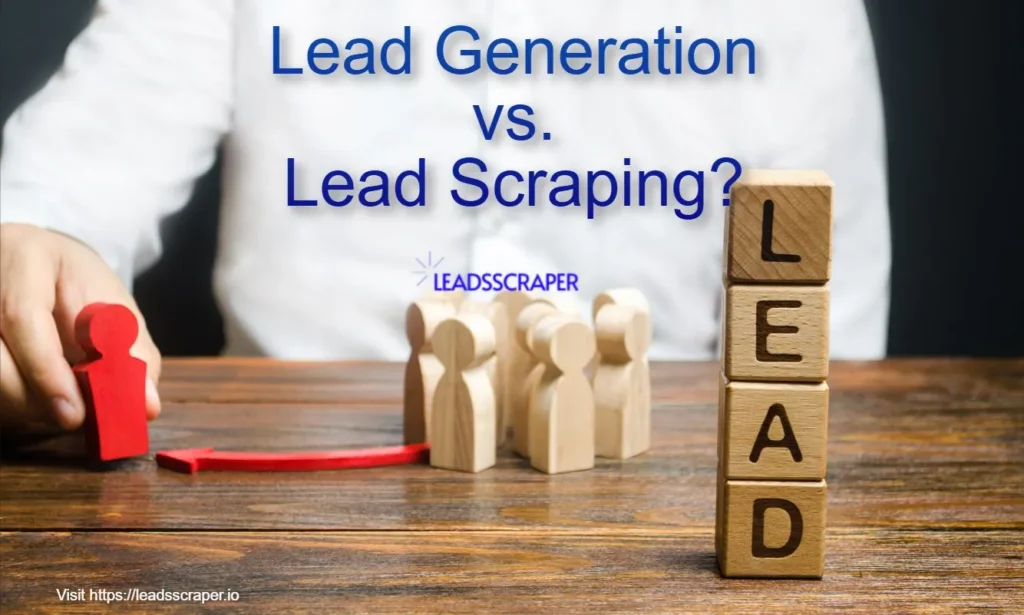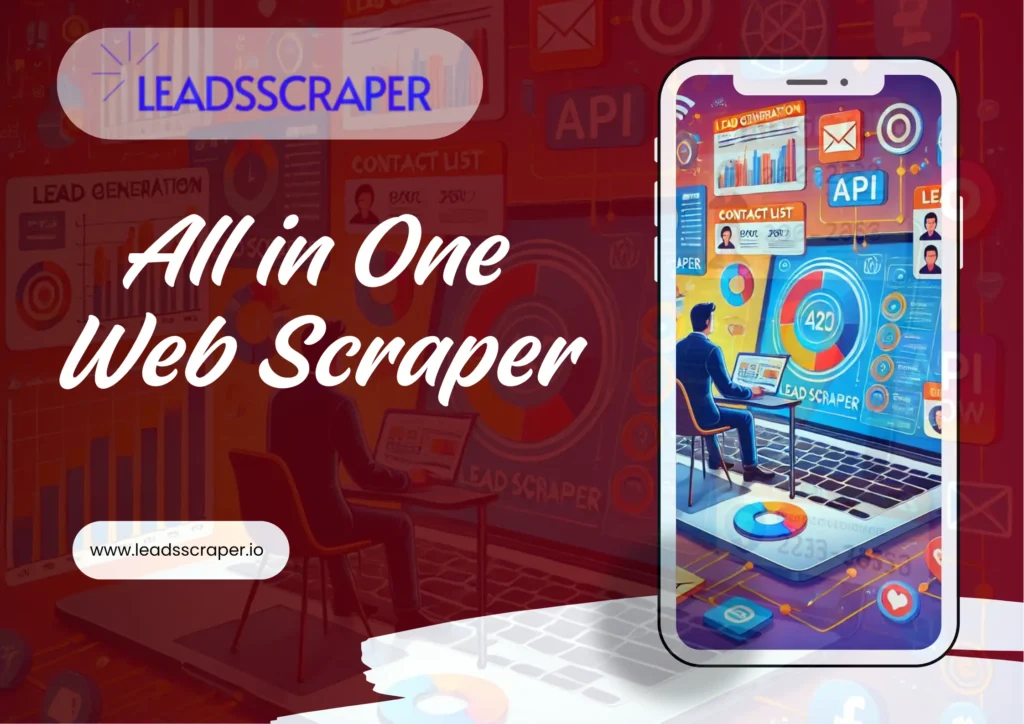Table of Contents
Introduction
Did you know that although lead generation and lead scraping are both used in business to identify potential customers they differ in how they obtain information? Every business, no matter what industry, craves more leads to fuel business growth, but most of them are often stuck trying to fill their sales pipeline.
In the B2B industry, there’s an ongoing debate about which one is better, lead generation or lead scraping in identifying potential customers or how to get more customers.
Lead generation is the act or process of generating consumer interest in a product or service and converting it into sales while lead scraping is the automated process of collecting contact information from publicly available websites.
These two terms are sometimes used interchangeably, but they are not the same. There’s a huge difference between lead generation and lead scraping, and in this article, we will break down what lead generation and lead scraping truly mean.
We will also guide you toward the best approach for your business. You will discover the difference between lead generation and Lead scraping. One strategy builds lasting relationships to drive sustainable growth while the other is a shortcut with some serious caveats. Are you now ready to make an informed choice? Let’s explore!
Google Maps Data Scraper
Leadsscraper.io’s Google Maps Data Scraper helps you find, extract, and download valuable business information from Google Maps listings — no coding, no manual copy-pasting, no hassle.
Understanding Lead Generation
Lead generation is the act or process of identifying or generating consumer interest in a product or service and converting it into sales. Lead generation attracts and converts consumers’ interests into sales. It is about inviting people to engage, building relationships based on trust, and ensuring all interactions are permission-based.
In online marketing lead generation typically involves collecting a visitor’s contact information also called a lead through outbound and inbound marketing strategies. It is an appealing display so interested individuals come to you, rather than you having to seek them out. There are different tools for outbound lead generation and at the same time there are also tools for outbound lead scraping available online.
The focus of lead generation is on building interest and nurturing potential customers. Some of the methods used include content marketing, email campaigns, social media advertising, networking, and other techniques to attract and engage potential buyers. Its goal is to create a pipeline of qualified leads who are interested in your product or service.
How Does Ethical Lead Generation Work?
Ethical lead generation uses practical, value-first strategies to attract and engage prospects:
- Content Marketing: Creating helpful articles, videos, or e-books that solve audience problems.
- SEO: Optimizing your online presence so people find you organically when searching for solutions.
- Social Media Marketing: Engaging with your audience and fostering community, not just selling.
- Email Marketing (Opt-in): Nurturing leads who explicitly want to receive your communications.
- Webinars/Events: Offering free, valuable learning experiences to gather interested sign-ups.
- Referral Programs: Encouraging satisfied customers to recommend new ones.
- Targeted Paid Ads: Using ads that lead to valuable content or offers, reaching specific, interested audiences.
The Advantages of Lead Generation
Embracing ethical lead generation yields significant benefits:
- High-Quality Leads: Attracting people who are genuinely interested, leads to higher conversion rates.
- Stronger Relationships: Building trust and loyalty with your audience.
- Better Brand Reputation: Being seen as a helpful, reliable resource.
- Long-Term Sustainability: Creating a consistent and ethical pipeline for sustained business growth.
- Compliance & Ethics: Operating with integrity, avoiding legal issues, and resonating with conscious consumers.
Understanding Lead Scraping
Lead scraping is the automated process of collecting contact information such as names, emails, phone numbers, and company data from publicly available websites using specialized software or bots. Lead scraping which is also known as web scraping or data extraction is a technique often used in connection with lead generation.
This process collects data from websites, databases, or social media platforms by harvesting data systematically, often without direct interaction or explicit permission from the individuals concerned, and compiling the data into a lead list.
How Lead Scraping Works?
The process is generally straightforward: specialized software or “bots” are deployed to systematically browse or “crawl” the internet. These bots are programmed to identify and extract specific types of public data such as names, email addresses, job titles, company information, and sometimes even phone numbers.
Once collected, this raw data is then compiled into large lists or spreadsheets, ready for potential use. The collected scraped data is organized and most companies integrates these data into their Customer Relationship Management (CRM) systems for targeted marketing and sales activities.
Some of the benefits of lead scraping include the following:
- Speed: Rapid acquisition of large contact lists.
- Volume: Potential for huge quantities of contacts.
- Low Initial Cost: Seemingly affordable on a per-contact basis, considering only the tool’s price.
Speaking of benefits, there are also disadvantages of using lead scraping:
- Low-Quality Leads: Data is untargeted, often outdated, and consists of uninterested contacts.
- Technical Complexity: Setting up and maintaining lead scraping tools can require technical expertise. It is important to look for no-code-required scraping tools like LeadsScraper.
- Email Deliverability Problems: Results in high bounce rates, spam complaints, and blacklisting. Before sending emails make sure you use LeadsScraper’s Email Address Verifier.
- Short-Term Mindset: Focuses solely on volume, neglecting long-term relationship building essential for sustainable growth.
In essence, while lead scraping offers a quick way to gather contacts, but sometimes delivers low-quality leads, and carries legal and ethical liabilities, therefore it is important to use tools that guide you on how to effectively use lead scraping for genuine business development.
Google Maps Data Scraper
Leadsscraper.io’s Google Maps Data Scraper helps you find, extract, and download valuable business information from Google Maps listings — no coding, no manual copy-pasting, no hassle.
How Lead Scraping Fits Into Lead Generation
Lead scraping is closely related to lead generation as most businesses consider lead scraping as a technique often used in connection with lead generation. Both lead generation and lead scraping involve data collection and targeted outreach to turn prospects into customers.
It is a tool that facilitates lead generation by providing a way to quickly and efficiently collect the contact information needed to identify and engage with potential customers.
Lead scraping involves the following:
- Data Collection: It helps gather a large volume of contact information from various online sources, which is a key component of lead generation.
- Targeted Outreach: By scraping or extracting data related to specific industries, roles, or locations, businesses can create a more targeted lead list.
- Automation: Lead scraping tools automate the data collection process, saving time and resources compared to manual research.
- Efficiency: scraping allows businesses to quickly build a database of potential leads, streamlining the early stages of the lead generation process.
Lead Generation vs. Lead Scraping: The Head-to-Head Comparison
| Feature | Lead Generation | Lead Scraping |
Method | Attracts interested prospects, permission-based | Extracts public data, often without permission |
Quality | High, pre-qualified, genuinely interested | Low, untargeted, often inaccurate, outdated |
Legality/Ethics | Compliant, builds trust, respects privacy | Risky, often violates privacy laws (GDPR, CCPA) |
Relationships | Builds strong, long-term connections | Non-existent, often creates animosity |
Conversions | High, warm leads more likely to convert | Low, high bounce/spam rates, minimal engagement |
Sustainability | Long-term, scalable, consistent pipeline | Short-sighted, unsustainable, prone to issues |
Effort | Consistent, strategic, value-driven | Quick initial setup, but high downstream effort |
Despite the significant problems and challenges associated with lead scraping, it remains a common practice for several reasons, primarily due to its perceived immediate benefits and the speed of data acquisition.
Here’s why it’s still used and how some companies mitigate its downsides:
- Speed and Volume: For companies needing to quickly build a large database of contacts, especially in niche B2B markets where public information is fragmented, scraping offers unparalleled speed and volume compared to manual research or slower, permission-based lead generation.
- Market Intelligence: Beyond direct lead generation, scraping is often used for market research and competitive intelligence. It is used to analyze competitor pricing, product features, job postings or industry trends.
- Filling Gaps: In certain industries or for very specific roles, public data might be the only readily available source of contact information.
- Cost Perception: While the downstream costs of bad data are high, the initial cost of a scraping tool or service can appear very low, making it seem like a budget-friendly option for list building.
Preventing Low Data Quality with "Trusted" Scrapers:
While no scraper can guarantee perfect data quality or ethical compliance without permission, companies that still use scraping often try to mitigate low data quality by:
- Using Reputable Tools/Services: Some “trusted” scrapers or data providers claim to employ more sophisticated algorithms that filter out common errors (e.g., invalid email formats, duplicate entries, common honeypot traps).
- Targeted Scraping: Instead of broad, untargeted scraping, some companies focus on highly specific sources (e.g., industry-specific directories, and public professional profiles) to increase the relevance of the data. Some companies like LeadsScraper only focus on Google Maps scraping with added enrichment tools.
- Post-Scraping Verification: After scraping, companies might run the data through additional verification processes, such as email validation services, cross-referencing with other public databases, or even manual checks for key contacts. This adds a layer of quality control, though it increases effort and cost.
- Focus on Publicly Available & Business-Related Data: Companies might limit scraping to information that is clearly intended for public consumption and business contact, rather than personal data, to reduce ethical and legal risks.
Which One is Better For You? (The Verdict & Guidance)
When planning a course for business growth, the distinction between inviting genuine interest and simply accumulating contact details is very important. After weighing the distinct characteristics of lead generation and lead scraping, the answer for long-term business success is clear.
Lead generation is the clear winner, for any enterprise aiming for enduring, ethical, and genuinely profitable expansion. It is true that lead scraping can swiftly compile extensive lists of contacts, however, this benefit often comes at a steep price.
For business owners, we should focus on the reasons why building genuine connections is very important. Ethical lead generation succeeds because it aligns with a fundamental truth of commerce: you want customers who genuinely want to be your customers. It’s about cultivating a respected brand that is seen as a helpful resource, not a purveyor of unsolicited messages.
Actionable Advice for Sustainable Growth
To truly thrive by drawing the right people to your door, focus your energies on these proven strategies:
- Invest in Content That Solves Problems: Craft articles, videos, or guides that directly address the challenges or questions your ideal audience faces.
- Optimize Your Online Presence for Discovery: Ensure your website and online content are structured so that people actively searching for solutions you provide can find you naturally through search engines.
- Engage Authentically on Social Platforms: Use social media to build communities, share valuable insights, and spark meaningful conversations, rather than just broadcasting sales pitches.
- Cultivate an Opt-In Email Community: Invite individuals to willingly join your email list, promising to deliver value directly to their inbox.
- Prioritize Value at Every Interaction: From initial contact to post-purchase support, consistently offer insights, assistance, and genuine help. This reinforces trust and solidifies your brand as a dependable partner.
By embracing these principles, you build a robust and ethical pathway to connect with those who are truly seeking what you offer, ensuring a future of sustained and reputable growth.
Conclusion: Planning for Lasting Growth
After exploring the difference between Lead Generation vs. Lead Scraping in attracting potential customers, the resolution to the debate between them is unequivocally clear. For any business fundamentally committed to enduring, ethical, and genuinely profitable expansion, the strategic choice is lead generation.
While the rapid collection of contacts via lead scraping might initially appear to offer an enticing shortcut, its perceived benefits are overshadowed by liabilities. This approach yields quick numbers, but it inherently lacks the foundation for meaningful engagement.
The true strength of lead generation lies in its ability to build genuine connections with interested prospects, fostering trust and leading to loyal customers and a positive brand image. This strategic investment, though it requires effort, yields high-quality leads and strong conversion rates.
Your journey to consistently attract the right customers begins with a conscious decision to prioritize value and authenticity. If you are ready to boost your lead generation efforts and ensure the quality of your outreach, consider exploring tools that support precise data acquisition and robust verification.
Solutions offered by LeadsScraper such as Google Maps Scraper, can aid in highly targeted data collection from specific sources like Google Maps, and enriched it with Email & Contacts Scraper. Furthermore, to make sure that you will reduce your bounce rate, you can utilize the integrated Email verification and validation features. These tools are crucial for maintaining clean lists and maximizing deliverability within your broader lead generation strategy.
Build your business on a foundation of unwavering trust, and the leads will undoubtedly follow. Try LeadsScraper for FREE now!
FAQ
Most frequent questions and answers
Lead generation is the act or process of identifying or generating consumer interest in a product or service and converting it into sales.
Lead scraping is the automated process of collecting contact information such as names, emails, phone numbers, and company data from publicly available websites using specialized software or bots.
Lead generation is the act or process of generating consumer interest in a product or service and converting it into sales while lead scraping is the automated process of collecting contact information from publicly available websites.
Google Map scraping, harvesting, or extracting is a process of getting all the information about places (name, address, coordinates, site, phone, working hours, etc.) from the Google Maps site. It automates manual exporting of the data.
Google Map scraping, harvesting, or extracting is a process of getting all the information about places (name, address, coordinates, site, phone, working hours, etc.) from the Google Maps site. It automates manual exporting of the data.
LeadsScraper offers Google Maps Scraper, Emails & Contacts Scraper, and Email Address Verifier. Choose the tool you need or combine all three for a full lead generation workflow. Start for FREE using Leadsscraper.io



